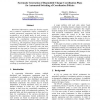667 search results - page 2 / 134 » Learning to Model Sequences Generated by Switching Distribut... |
NN
2010
Springer
13 years 5 months ago
2010
Springer
This study shows that a mixture of RNN experts model can acquire the ability to generate sequences that are combination of multiple primitive patterns by means of self-organizing ...
KBSE
2000
IEEE
13 years 11 months ago
2000
IEEE
Distributed information systems for decision support and e-commerce applications require coordination of multiple autonomous components and their services to accomplish a set of g...
ICML
2006
IEEE
14 years 8 months ago
2006
IEEE
We propose a new model for the probabilistic estimation of continuous state variables from a sequence of observations, such as tracking the position of an object in video. This ma...
ICML
2010
IEEE
13 years 8 months ago
2010
IEEE
We develop a semi-supervised learning method that constrains the posterior distribution of latent variables under a generative model to satisfy a rich set of feature expectation c...
EELC
2006
13 years 11 months ago
2006
We present a neural-competitive learning model of language evolution in which several symbol sequences compete to signify a given propositional meaning. Both symbol sequences and p...

